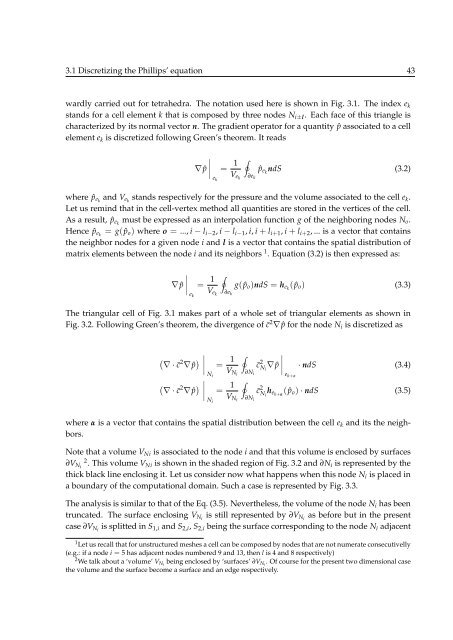THESE de DOCTORAT - cerfacs
THESE de DOCTORAT - cerfacs
THESE de DOCTORAT - cerfacs
Create successful ePaper yourself
Turn your PDF publications into a flip-book with our unique Google optimized e-Paper software.
3.1 Discretizing the Phillips’ equation 43<br />
wardly carried out for tetrahedra. The notation used here is shown in Fig. 3.1. The in<strong>de</strong>x e k<br />
stands for a cell element k that is composed by three no<strong>de</strong>s N i±l . Each face of this triangle is<br />
characterized by its normal vector n. The gradient operator for a quantity ˆp associated to a cell<br />
element e k is discretized following Green’s theorem. It reads<br />
∇ ˆp<br />
⏐ = 1 ∮<br />
ˆp ek ndS (3.2)<br />
ek<br />
V ek ∂e k<br />
where ˆp ek and V ek stands respectively for the pressure and the volume associated to the cell e k .<br />
Let us remind that in the cell-vertex method all quantities are stored in the vertices of the cell.<br />
As a result, ˆp ek must be expressed as an interpolation function g of the neighboring no<strong>de</strong>s N o .<br />
Hence ˆp ek = g( ˆp o ) where o = ..., i − l i−2 , i − l i−1 , i, i + l i+1 , i + l i+2 , ... is a vector that contains<br />
the neighbor no<strong>de</strong>s for a given no<strong>de</strong> i and l is a vector that contains the spatial distribution of<br />
matrix elements between the no<strong>de</strong> i and its neighbors 1 . Equation (3.2) is then expressed as:<br />
∇ ˆp<br />
⏐ = 1 ∮<br />
g( ˆp o )ndS = h ek ( ˆp o ) (3.3)<br />
ek<br />
V ek ∂e k<br />
The triangular cell of Fig. 3.1 makes part of a whole set of triangular elements as shown in<br />
Fig. 3.2. Following Green’s theorem, the divergence of ¯c 2 ∇ ˆp for the no<strong>de</strong> N i is discretized as<br />
( ∇ · ¯c 2 ∇ ˆp ) ⏐ ⏐⏐Ni = 1 ∮<br />
¯c 2 N<br />
V i<br />
∇ ˆp<br />
Ni<br />
⏐ · ndS (3.4)<br />
∂N i ek+α<br />
( ∇ · ¯c 2 ∇ ˆp ) ⏐ ⏐ ⏐⏐Ni = 1<br />
V Ni<br />
∮<br />
∂N i<br />
¯c 2 N i<br />
h ek+α ( ˆp o ) · ndS (3.5)<br />
where α is a vector that contains the spatial distribution between the cell e k and its the neighbors.<br />
Note that a volume V Ni is associated to the no<strong>de</strong> i and that this volume is enclosed by surfaces<br />
∂V Ni 2 . This volume V Ni is shown in the sha<strong>de</strong>d region of Fig. 3.2 and ∂N i is represented by the<br />
thick black line enclosing it. Let us consi<strong>de</strong>r now what happens when this no<strong>de</strong> N i is placed in<br />
a boundary of the computational domain. Such a case is represented by Fig. 3.3.<br />
The analysis is similar to that of the Eq. (3.5). Nevertheless, the volume of the no<strong>de</strong> N i has been<br />
truncated. The surface enclosing V Ni is still represented by ∂V Ni as before but in the present<br />
case ∂V Ni is splitted in S 1,i and S 2,i , S 2,i being the surface corresponding to the no<strong>de</strong> N i adjacent<br />
1 Let us recall that for unstructured meshes a cell can be composed by no<strong>de</strong>s that are not numerate consecutivelly<br />
(e.g.: if a no<strong>de</strong> i = 5 has adjacent no<strong>de</strong>s numbered 9 and 13, then l is 4 and 8 respectively)<br />
2 We talk about a ‘volume’ V Ni being enclosed by ‘surfaces’ ∂V Ni . Of course for the present two dimensional case<br />
the volume and the surface become a surface and an edge respectively.
















